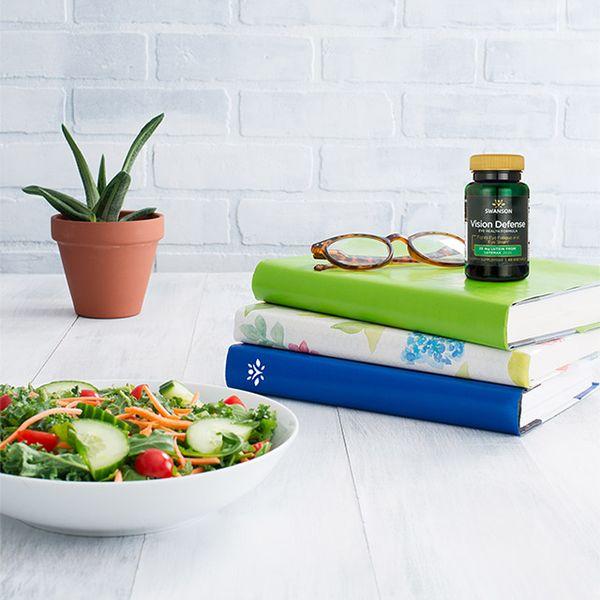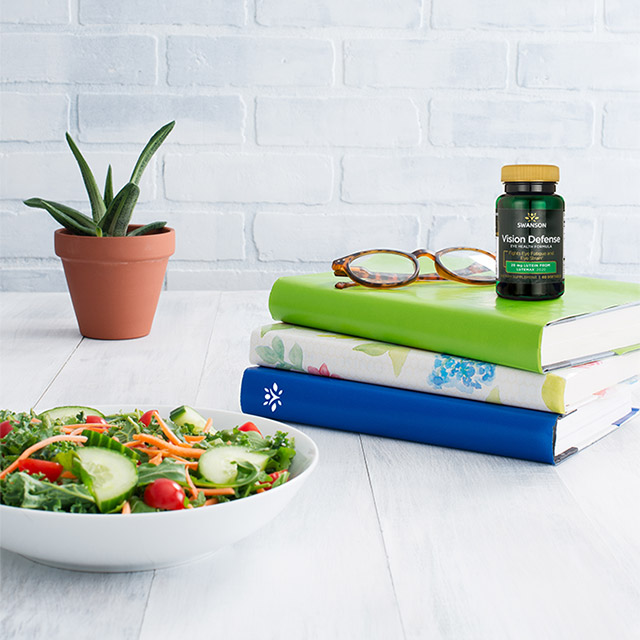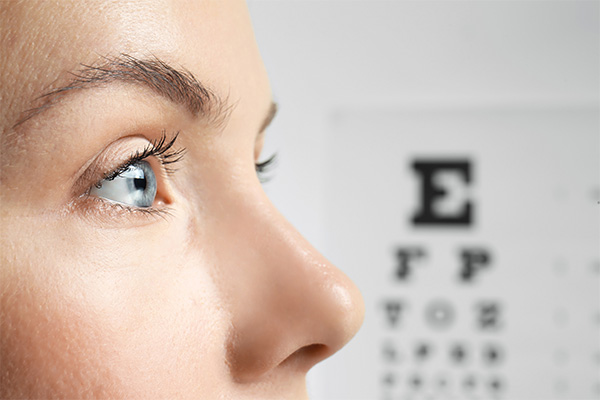Nutrition for Eye Health
Why is eye health so important? Taking care of your eyes might not be something you think about often, beyond having your vision checked and wearing sunglasses, but it takes more than that. You can get ahead of potential age and lifestyle-related eye concerns and keep your eyes healthy by making small changes to your habits and focusing on nutrition that supports eye health. One of the biggest concerns in eye health is exposure to blue light from our electronic screens and devices.

What is Blue Light?
Blue light is a type of electromagnetic ray that is emitted from the screens of electronic devices, but there are other sources of blue light too. Since the average person spends up to 11 hours a day in front of a digital screen (smartphone, tablet or computer), most of our blue light exposure comes from electronic devices.1 It’s important for us to take steps to protect our vision from all that exposure to blue light, but what is it about blue light that's so special and potentially harmful?
It really isn’t the color that’s the problem. Light is made up of electromagnetic particles and those particles travel in what’s known as waves. The lengths of those waves vary depending on the color of the light—with red being the longest, and blue being the shortest on the visible light spectrum.8 Since blue rays of light are shorter and more energetic than any other type of visible light, they're more damaging to our retinas.9
In fact, blue light is very close to ultraviolet (UV) light, which is not visible to the human eye. The natural filters in your eyes help to protect against blue light rays, and there are things you can do to help protect your eyes as well like adding plenty of protective macular carotenoids to your diet.
Blue Light Facts
- Smartphones and tablets emit more blue light than any other source, which can negatively affect your body's natural circadian rhythm (sleep/wake cycle)2
- The average American adult spends more than 11 hours per day on electronic devices1
- Teens spend an average of nine hours a day in front of screens, while tweens average six hours of screen time3
- 40% of adults work in jobs that require prolonged use of a computer or tablet, and two-thirds of Americans say they haven’t discussed their digital device usage with their eye care provider4
- About 70% of adults who regularly use media devices experience symptoms of digital eye stair, but due to lack of knowledge, many do nothing to protect their eyes from digital eye strain4
- Half of eye doctors have reported an increase in digital eye strain and effects from blue light exposure among their patients5
- Lutein and zeaxanthin are the only two carotenoids that provide protection for your retinas from blue light, but your body doesn’t make them naturally6
What are Macular Carotenoids?
Macular carotenoids are pigments found in a variety of foods and in supplements.10 They help your eyes because when you consume them, the pigments are deposited heavily in your retinas and they form a protective layer against damage, helping filter out blue light rays. Put simply, macular carotenoids help protect your eyes from the effects of blue light exposure similar to how sunglasses help protect your eyes from the effects of UV rays from the sun.11
Lutein and zeaxanthin are the two macular carotenoids linked to protecting your eyes, and studies have shown that people who consume them also have a lower risk for age-related eye concerns.7
Macular Carotenoid Food Sources
Lutein and Zeaxanthin are found in the following foods:
- Egg Yolks
- Corn
- Avocados
- Tomatoes
- Kale
- Spinach
- Swiss Chard
- Mustard Greens
- Turnip Greens
- Collard Greens
- Garden Cress
- Dandelion Greens
- Some Spices (like paprika & cayenne)
Other foods that are healthy for your eyes include:
- Orange fruits & vegetables (contain beta carotene)
- Fatty fish (contain eye-healthy omega-3 fatty acids)
- Dark berries (contain antioxidant vitamins & anthocyanosides)
- Citrus fruits (contain vitamin C & citrus bioflavonoids)
Supplements for Eye Health
Macular carotenoids are also readily available in supplements, like Swanson’s Synergistic Eye Health, which features high-quality lutein and OmniXan® zeaxanthin. Since these are fat-soluble carotenoids, they are absorbed better when taken with fat, such as the sunflower seed oil base of our softgels.
Another potent ally for long-term eye and vision health is Swanson’s Vision Defense Eye Health Formula. This blend features both lutein and zeaxanthin, along with an innovative new antioxidant blend including TrueBroc® broccoli extract, Mirtoselect® bilberry extract and AstaPure® astaxanthin to boost the effects of lutein.
You can see Swanson’s full range of supplements for vision health here.
Quick Tips on How to Build Extraordinary Eyes
Want to build extraordinary eye health? In addition to getting your daily dose of the macular carotenoids lutein and zeaxanthin, here are some quick tips on building better eye health:
- Limit screen time when you’re not working. Read a printed book or magazine, take a walk, or find other deviceless activities or hobbies to enjoy
- When you are using electronic devices, blink frequently and take breaks from looking at the screen. Embrace the 20-20-20 rule: look at an object at least 20 feet away for 20 seconds every 20 minutes
- Put away devices before bedtime. Limiting screen time before bed will help you sleep better because blue light exposure at night can also disrupt your natural sleep and wake cycle
- Use nighttime settings on your devices and keep your charging-station in another room, not on your bedside table. Charging devices in another room at night will help limit blue light exposure and reduce the temptation to use devices before bedtime
- Add leafy greens, like spinach, kale, collard and turnip greens, to your diet. Supersize your benefits by adding orange- and yellow-colored fruits and vegetables, like peppers, squash and corn, to your diet too
- Add vision health supplements with lutein, zeaxanthin and astaxanthin to your daily routine to help make sure your eyes are protected. Try Swanson's Vision Defense formula or Synergistic Eye Health for blue light eye protection
It’s important to show your eyes some love with these tips for better eye health. You might also like reading Important Facts about Blue Light and Eye Health and Top Foods that Promote Eye Health.

About Amy Sunderman, MS, RD
Amy is a registered dietitian, nutritionist and author with more than 20 years of experience in the supplement industry. Amy is passionate about dietary supplements and the health benefits they offer. She enjoys working to find novel nutritional ingredients with strong clinical research behind them to drive innovation and provide health-promoting products to consumers.
*These statements have not been evaluated by the Food and Drug Administration. These products are not intended to diagnose, treat, cure, or prevent any disease.
Sources
1. Americans Use Electronic Media 11+ Hours A Day. Statista. Read source
2. The Color of Light Affects the Circadian Rhythm. CDC. Read source
3. Digital Media and Your Children and Teens. American Academy of Pediatrics. Read source
4. Digital Eye Strain. The Vision Council. Read source
5. Digital Eye Strain. National Institutes of Health. Read source
6. Lutein & Zeaxanthin. American Optometric Association. Read source
7. Macular Carotenoids: Lutein and Zeaxanthin. National Library of Medicine. Read source
8. The Color of Light. American Museum of Natural History. Read source
9. Blue Light. Harvard Health Publishing. Read source
10. Macular Carotenoids. National Institutes of Health. Read source
11. Macular Carotenoid Supplementation. Foods. Read source




